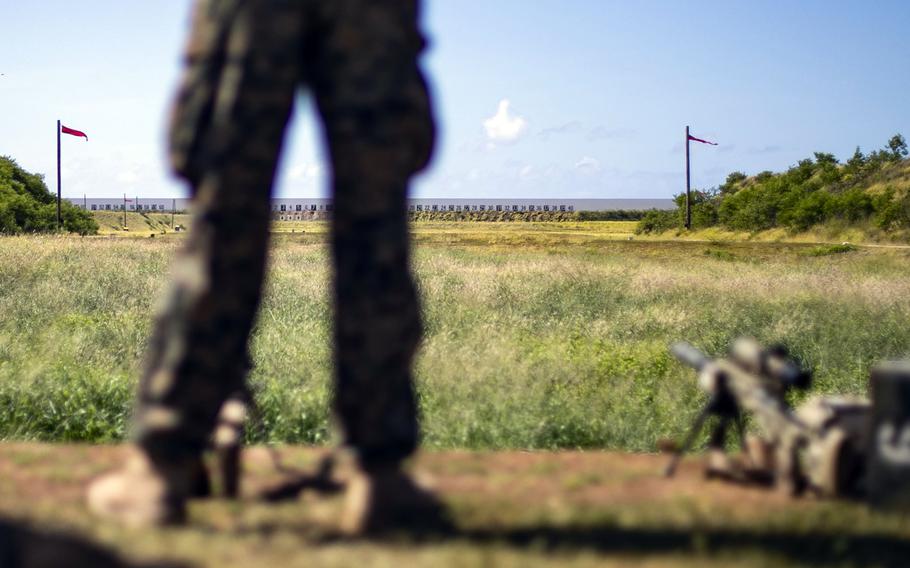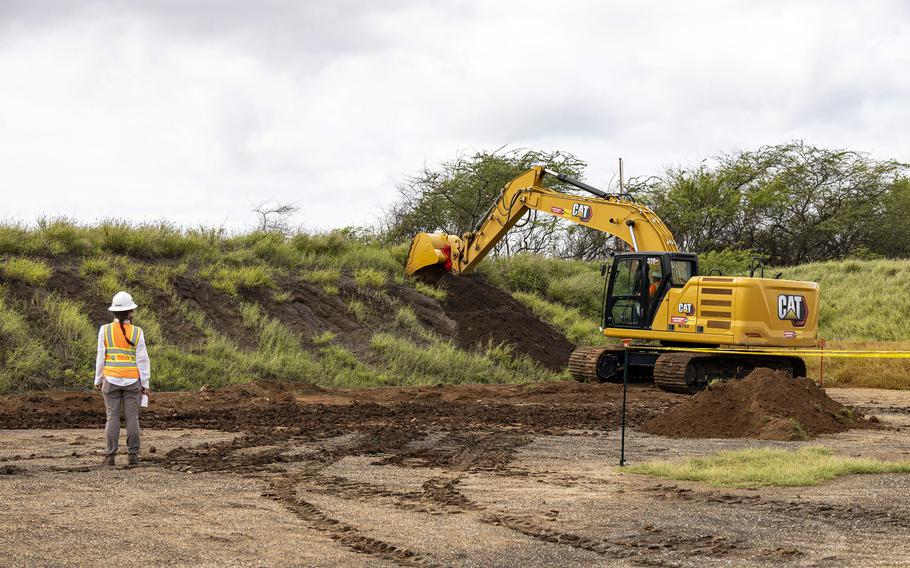
A Marine waits to fire from the 1,000-yard line at the Pu’uloa Range Training Facility, Ewa Beach, Hawaii, Aug. 1, 2019. (Jesus Sepulveda Torres/U.S. Marine Corps)
FORT SHAFTER, Hawaii — The Marine Corps has begun the process of moving inland the first of four short-distance firing ranges on Oahu threatened by encroaching beach erosion.
The initial steps to move Foxtrot Range roughly 44 yards inland at Pu’uloa Range Training Facility in Ewa Beach began in late February, 1st Lt. Mark McDonough, a spokesman for Marine Corps Base Hawaii, said by phone Wednesday.
The training facility lies across Pearl Harbor due west of Joint Base Pearl Harbor-Hickam. It also includes two long-distance firing ranges.
Relocating the small-arms ranges at the site is part of a multiyear effort to protect the facility from erosion and to prevent possible beach contamination from bullet lead.
“Pu’uloa Range Training Facility is an essential part of the Marine Corps’ training resources on the island of Oahu,” Maj. Jeffry Hart, director of Marine Corps Base Hawaii’s Environmental Compliance and Protection Division, said in a March 2 news release.
“We have a responsibility to protect the natural resources we are entrusted to manage,” he said.
Ranges Charlie, Delta and Echo are slated to be relocated next to Foxtrot as part of an overall military construction project being pursued by Marine Corps Base Hawaii, McDonough said.
Alpha and Bravo ranges are for long-distance firing, the longest at 1,000 yards and used for sniper training, he said. Soldiers also train on the long ranges.
The firing-range relocation is the second part of a three-phase plan that Marine Corps Base Hawaii unveiled in 2019 to stabilize the shoreline from erosion.
The first and ongoing phase was to enhance natural vegetation on shoreline berms to curtail erosion.
A proposed third phase called for burying metal sheets just off the shoreline from the Alpha and Bravo ranges to curb wave erosion. That plan met strong community opposition.
As a result, the plan was dropped in favor of using some type of natural vegetation as a barrier, McDonough said. That plan is still being developed, he said.

A backhoe moves earth on an impact berm at the Pu’uloa Range Training Facility, Ewa Beach, Hawaii, Feb. 23, 2023. (Samantha Sanchez/U.S. Marine Corps)
The firing ranges came under greater scrutiny after the Surfrider Foundation Oahu Chapter in early 2022 reported it had found elevated levels of lead in beach sand collected near the facility.
The samples, tested by Hawaii Analytical Laboratories LLC, found lead concentrations more than 70 times over accepted public health levels for residential areas.
“In response to this report, [Marine Corps Base Hawaii] invited personnel from the Hawaii Department of Health to visit the facility and conduct preliminary tests for munitions constituents (MC) alongside MCBH safety and environmental personnel,” McDonough said in an email Wednesday.
Samples taken at that time came from soil in the range’s impact berm and from beach sand seaward of the range.
“Results from samples taken from the impact berms did show the presence of MC, which includes lead,” he said. “However, results from samples taken from the beach sand did not show concentrations of lead exceeding allowable limits.”
“The presence of MC in firing range impact berms is inherent at any firing range and is not an indication of MC migration from the facility.”
The Foxtrot Range was selected for the first move because it is most vulnerable to erosion and, thus, possible migration of lead to beach sand, McDonough said.
But overall, relocation of all the ranges will “ensure good environmental stewardship,” he said.